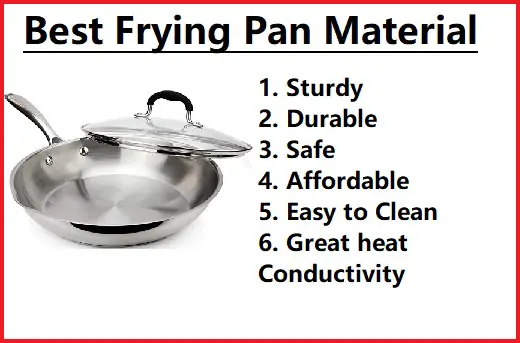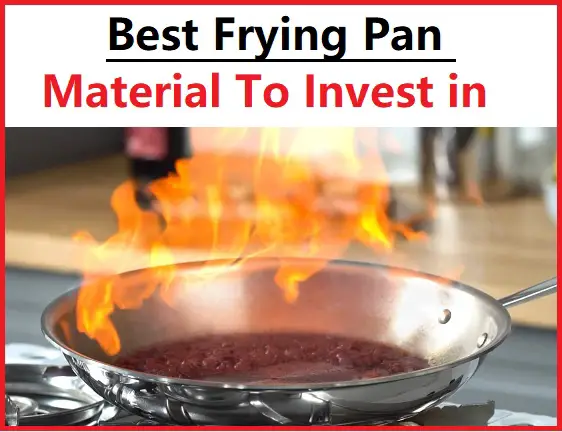
There are mostly 6 types of material-made frying pans available on the market. To pick the best frying pan material among them, we need to compare sturdiness, the safety of the constituent elements, longevity, wear, and tear rate for regular usage, and price point.
Being a professional chef, I have used several material-made pans. From efficiency, usage ease, durability and safety, stainless steel made frying pans are the best according to me. Stainless steel is the top frying pan material because it is light-weight, non-reactive to acidic food, iron-alloy hence infusion of iron may take place which is good for your health and is a style statement because of its look. The top rated stainless steel made frying pan is the All-Clad D3 Stainless which is the perfect choice for anyone who loves to cook. Beyond the classic stainless-steel style, you will find a well-constructed, high-performance, easy to use skillet for all, from beginner to culinary artist.

Here is the top 6 frying pan material according to their characteristics. Below the table, you will get a detailed analysis.
While buying a pan I give importance to the daily wear and tear rate the most. Then comes ease of usage. If the frying pan is easy to use and clean, it saves you a lot of time. Dishwasher safe frying pans are the best ones, as they are effortless to maintain. However, most material need regular seasoning. So if you don’t mind seasoning your pan, I will recommend you to buy a stainless steel frying pan. If stainless steel pan is pricey for you, invest in a carbon steel made frying pan. They are sturdy yet light-weight. Heat conduction capability is great hence your food will turn out evenly cooked. Carbon steel is also safe for regular use.
Detailed Guide on Best Frying Pan Material

Frying pans are essential kitchen utensils for any home chef. It is a versatile tool used for searing, frying, and browning ingredients. It usually comes with a flat bottom, a long handle, and a lid. Frying pans originated in Ancient Greece. Copper and cast-iron frying pans were more popular during those times. The 19th century witnessed the invention of cooking stoves and flat bottomed frying pans to go with it.
Given the wide variety of frying pans available in the market, choosing the right frying pan can be an overwhelming experience. You will find several frying pans made out of different materials. The question remains — how to choose the best frying pan material? I know that as a home chef, you may find it harrowing to pick the best one suited to your needs. That’s why I am going to share some tips to simplify the process.
Read on to know about the various frying pan materials in the market so that you know the ins and outs of how to choose the best frying pan material.
1. Stainless Steel
Stainless steel is a popular material for frying pans. Many chefs prefer it due to its excellent heat retention capabilities. Stainless steel is an iron-based alloy that contains chromium. It is scratch-resistant and very lightweight. It is also resistant to rust.

Pros:
- It is dishwasher safe. Stainless steel frying pans work well on induction stoves and standard ovens. It is also corrosion-proof.
- The durability of a stainless steel frying pan is higher compared to other materials. It is also non-reactive, making it easier to cook acidic food in it.
Cons:
Stainless steel pans that do not have a copper bottom may not conduct heat very well. It is not a naturally non-stick surface. Seasoning is mandatory for getting the best results from a stainless steel pan.
2. Carbon Steel
Carbon steel frying pans are a lightweight option, suited for amateur home chefs. It is incredibly durable and conducts heat well. It is a metal alloy consisting of iron and carbon. Many experienced chefs prefer using carbon steel as it is naturally non-stick.

Pros:
It has a very smooth surface due to the presence of smaller pores. It responds exceptionally well to any adjustments in the heat. It is induction and oven friendly.
Cons:
It is significantly more expensive compared to the other materials. It is not naturally rust-free. The handles can also become really hot if not covered. Moreover, a carbon steel pan cannot be placed in the dishwasher directly. Handwashing the pan could be a hassle for many.
3. Aluminum
Aluminum frying pans are one of the bestsellers in the market. As aluminum is abundantly available in the earth’s atmosphere, it is cheaper than stainless steel or copper. High-quality aluminum frying pans contain 99.99% pure aluminum. It is also lightweight, making it a good option for both commercial and home kitchens.

Pros:
Aluminum pans conduct heat very well. It is also easy to clean. It is usually scratch-resistant and rust-free.
Cons:
These frying pans need proper seasoning to protect it from wear and tear. They are not as durable as compared to steel. Moreover, Aluminum may leach into your food, posing a lot of health hazards.
4. Anodized Aluminum
Given the significant health risks associated with aluminum, anodized aluminum frying pans are a safer alternative. Dissolving aluminum oxide in sulfuric acid or chromic acid achieves anodization. These pans are also more durable and almost at par with stainless steel frying pans.

Pros:
Anodized aluminum frying pans are lightweight. They are also non-reactive as the non-porous coat locks the aluminum particles inside and prevent leaching. The surface is non-stick but does not contain a Teflon coating. These pans conduct heat evenly. You can clean them without much hassle. It is also scratch-resistant, making it an ideal pick for even those who have just started cooking.
Cons:
These frying pans cannot be pre-heated at an extremely high temperature for long. The heat conductivity is weaker compared to pure aluminum frying pans. You cannot use cooking sprays as that may end up making the surface sticky.
5. Cast Iron
Cast iron frying pan is a piece of classic kitchen equipment, passed down from one generation to the other. These pans are composed of pure iron and approximately 4% carbon and 1 to 3% silicon. While cast-iron frying pans can be intimidating for newcomers, it is extremely easy to use once you get the hang.

Pros:
You can use these frying pans for cooking almost anything since they are versatile. Iron particle fortifies the food cooked in these pans. These frying pans are famous for their heat retention capabilities. A well-seasoned cast-iron frying pan provides a naturally non-stick surface. These frying pans are also affordable.
Cons:
These frying pans are extremely heavy, making it difficult to move them around quickly. You need to season it regularly to achieve the best results. These pans also take a lot of time to heat up properly. Some cast-iron frying pans can develop rust over time.
6. Enameled Cast Iron
If you want a good looking frying pan in your kitchen, it is time to bring home an enameled cast iron frying pan. A vitreous enamel glaze coats the surface of these cast-iron frying pans. These pans are durable and safe to use.

Pros:
The pan has a non-stick surface, thanks to the enamel coating. You can crank up the heat without any worry and use the pan for braising or searing. These frying pans retain heat very well. The presence of enamel coating diminishes the need for additional seasoning.
Cons:
These pans can be extremely heavy, making them unfit for daily use. The enamel coating is prone to chipping. These frying pans are also more expensive compared to the regular cast-iron frying pans.






